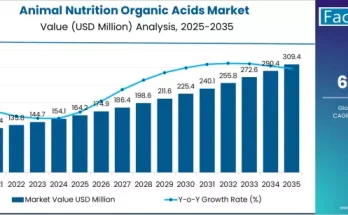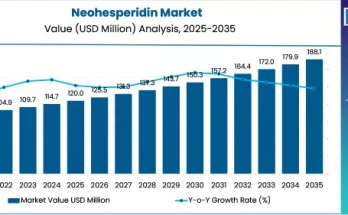The Microbial-Derived Fiber Market is on track for remarkable growth, expanding from USD 680.0 million in 2025 to USD 1,250.0 million by 2035, marking an absolute increase of USD 570.0 million and a 1.8x expansion over the decade. Driven by global interest in sustainable biotechnology, microbial fermentation techniques, and high-purity bacterial cellulose, the market is expected to transform manufacturing standards across food packaging, cosmetic formulations, and biomedical applications. Despite production scaling and supply chain challenges, strong regional growth in Asia Pacific, Europe, and North America continues to anchor long-term opportunities for manufacturers and investors alike.
Market Outlook and Growth Drivers
The Microbial-Derived Fiber Market represents a new frontier in bio-based materials innovation, integrating biotechnology and advanced fermentation processes to produce high-purity, sustainable fibers from bacteria, fungi, yeast, and algae. Bacterial cellulose remains the dominant segment, accounting for nearly 55.0% of total market share in 2025, owing to its superior crystallinity, tensile strength, and structural purity compared to traditional plant-based cellulose.
Between 2025 and 2030, the market will expand by USD 280.0 million, contributing nearly 49.1% of total forecast growth. This phase will be characterized by growing applications in food packaging and cosmetic formulations, as companies increase investment in fermentation infrastructure and biotechnology integration. From 2030 to 2035, an additional USD 290.0 million growth will be driven by biomedical applications, advanced wound care materials, and tissue engineering solutions — collectively accounting for 50.9% of total decade expansion.
Key demand factors driving the Microbial-Derived Fiber Market include:
-
Rising demand for bio-compatible, biodegradable fibers in packaging and medical applications.
-
Strong government support for biotechnology and bioeconomy initiatives.
-
Expansion of bioprocessing capabilities and automated fermentation systems improving cost efficiency and quality assurance.
-
Growing need for regulatory-compliant, high-purity cellulose in food and cosmetic manufacturing.
Regional Outlook
Asia Pacific Leads with Biotechnology Expansion
Asia Pacific is projected to remain the most dynamic region, accounting for over 40% of global market share by 2035. India (6.8% CAGR) and China (6.6% CAGR) are at the forefront, supported by national biotechnology programs, government-backed R&D incentives, and rapid industrialization in food and cosmetic sectors. Local partnerships between microbial fiber producers and biotechnology firms are accelerating domestic production and innovation.
North America Showcases Strong Innovation
The U.S. Microbial-Derived Fiber Market is projected to grow at 5.5% CAGR, supported by advanced biomanufacturing, high regulatory standards, and demand from medical and cosmetic companies. American manufacturers are increasingly investing in microbial fiber fermentation facilities to enhance product performance and reduce dependence on synthetic polymers.
Europe Focuses on Processing Excellence
Europe’s market is set to expand from USD 170.0 million in 2025 to USD 340.0 million by 2035 (CAGR 7.2%), with Germany and the UK maintaining leadership positions. The region benefits from a robust biotechnology ecosystem, regulatory alignment, and widespread adoption of microbial cellulose for sustainable packaging and biomedical solutions.
Segment Insights
By Type
-
Bacterial Cellulose: 55.0% market share; dominant due to purity, mechanical strength, and high-performance applications.
-
Fungal Fibers: 30.0% share; preferred in cosmetic and food sectors for their bioactive properties.
-
Other Microbial Types: 15.0% share; specialized compounds used in niche biotech applications.
By Application
-
Food Industry (40%): Driven by demand for eco-friendly packaging and edible film solutions.
-
Cosmetics (30%): Utilized for texture enhancement, moisture control, and natural formulation alignment.
-
Biomedical (30%): Applied in wound dressings, implants, and regenerative medicine.
Competitive Landscape
The Microbial-Derived Fiber Market is moderately consolidated, with 15–20 active players and top companies holding 30–35% of global share. Market leaders include Greenfiber, Nata de Coco, and ScobyTech, who dominate through advanced fermentation portfolios, global distribution networks, and biotechnology partnerships.
Emerging competitors such as CelluForce, Evonik, and Modern Synthesis are focusing on biotechnology diversification and localized production expansion across high-growth markets in Asia. Strategic collaboration between microbial producers, food processors, and cosmetic firms continues to shape industry direction, emphasizing purity assurance, fermentation automation, and sustainable sourcing.
Market Opportunities for Stakeholders
For Manufacturers:
The Microbial-Derived Fiber Market offers a pathway toward sustainable production and regulatory alignment. Manufacturers adopting microbial cellulose solutions can achieve up to 60% performance enhancement compared to plant-based alternatives while ensuring compliance and improving brand sustainability credentials.
For Investors:
Investors can unlock value through financing fermentation capacity expansion, supporting microbial startups, and enabling regional market development. Strategic investments in biotechnology clusters across India, China, and Germany can yield long-term ROI as microbial materials become mainstream industrial inputs.
For Policy Makers:
Governments can accelerate growth through R&D incentives, fermentation infrastructure funding, and biotechnology skill development programs to enhance national competitiveness in sustainable manufacturing.
Browse Full Report : https://www.factmr.com/report/microbial-derived-fiber-market
Conclusion
The Microbial-Derived Fiber Market is set for robust and sustainable expansion between 2025 and 2035, driven by technological innovation, sustainability imperatives, and the rise of biomanufacturing ecosystems. As bio-based materials transition from niche to mainstream applications, microbial fibers will play a pivotal role in redefining food packaging, cosmetic innovation, and biomedical product development. For manufacturers and investors seeking scalable, high-performance bio-material solutions, this market represents one of the most promising growth frontiers of the decade.



